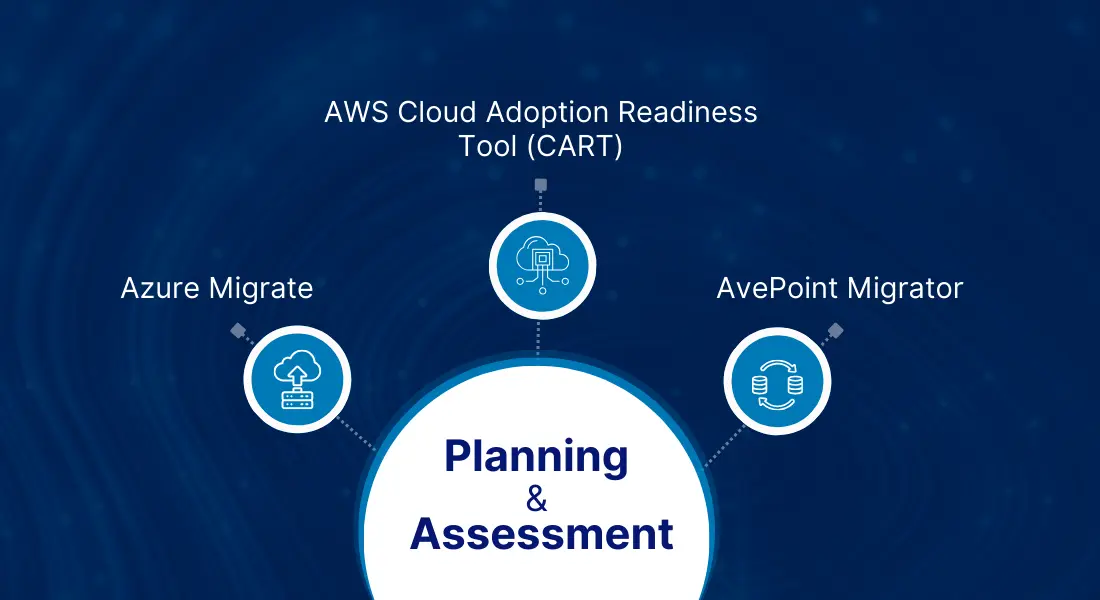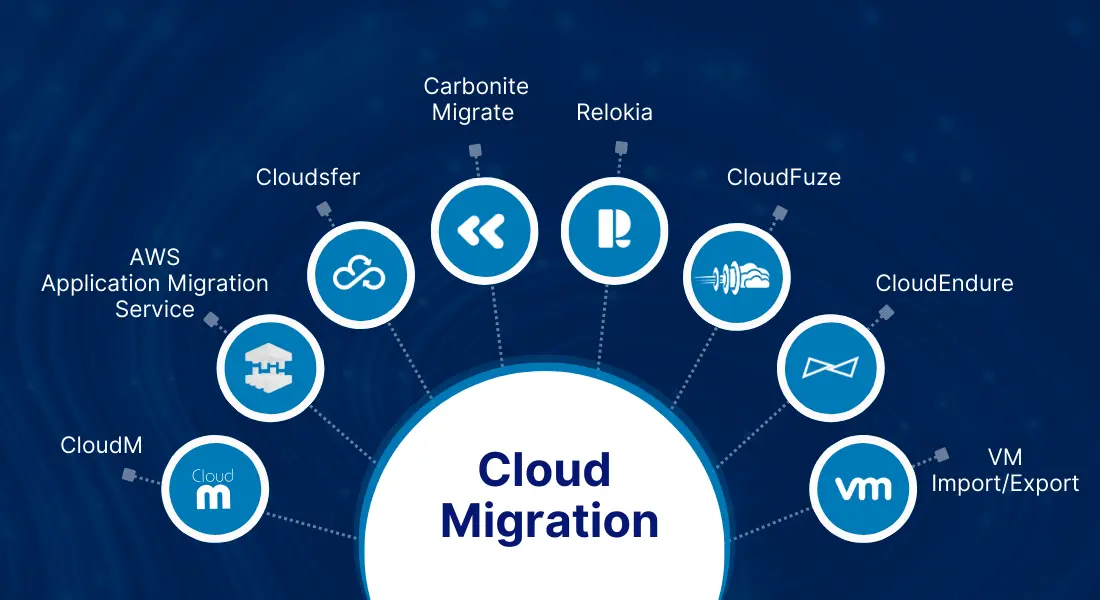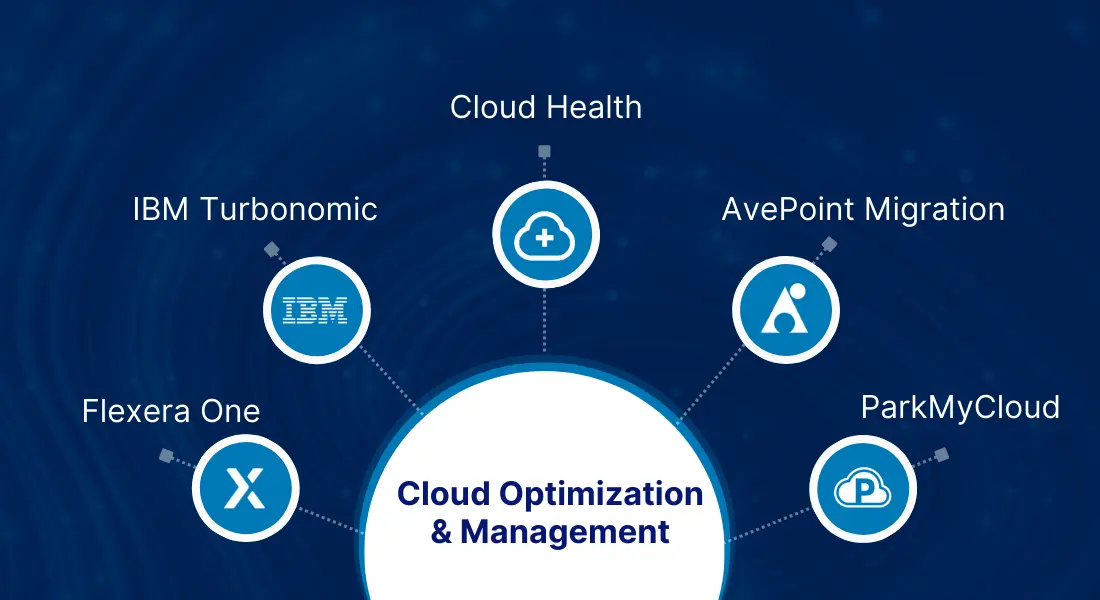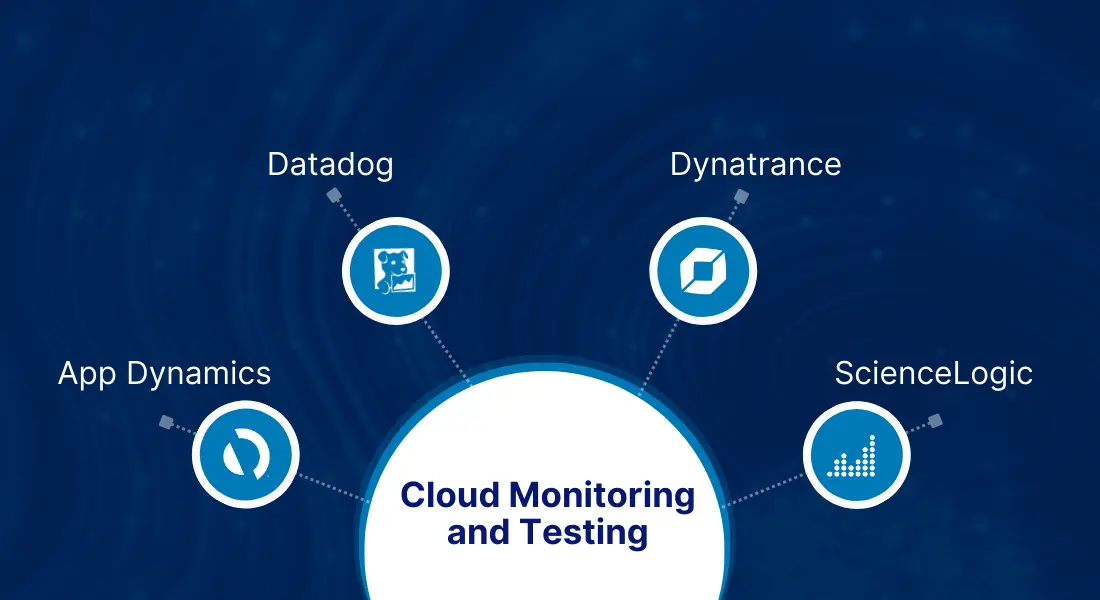Summary
Discover an exclusive curated list of Cloud migration tools necessary to cover every essential aspect of the entire cloud migration journey. Whether you’re evaluating business planning and readiness, simply migrating, optimizing & managing cloud resources and costs, or worrying about the after-party monitoring and testing process, we have tools for you every step of the migration process!
Table of Contents
Introduction
Cloud migration has emerged as a strategic maneuver for organizations seeking to leverage the benefits of flexibility, scalability, and cost efficiency inherent in cloud environments. However, this transition, whether from on-premises setups or between cloud providers, comes with its fair share of challenges. These challenges, including unplanned downtime, data loss, security vulnerabilities, and project delays, underscore the need for efficient cloud migration tools. By providing automation, security measures, compliance assurances, and efficient issue resolution, these tools mitigate risks and ensure a smoother transition, allowing businesses to swiftly realize the full potential of the cloud. We’ve listened to your needs and handpicked a curated list of tools to assist you at every step of the migration process. Take a look and streamline your cloud migration journey today!
Top Cloud Migration Tools
Think of our list as a roadmap divided into four essential parts, each representing a crucial stage in the cloud migration journey. Let’s dive in and explore each step with different cloud migration tools.
Step 1- Planning & Assessment
Planning and Assessment is the pivotal phase where the groundwork for seamless transition is laid. It involves meticulous analysis, strategizing, and understanding the existing infrastructure to pave the way forward. Here are the essential tools required to navigate this crucial phase:

1. Azure Migrate
Azure Migrate is a tool of choice when you intend to migrate to Azure cloud. It helps as a central hub to discover and assess your environment (VMs, databases, apps) before migration. It easily integrates with other cloud migration tools to assess the readiness of your IT infrastructure for cloud migration, understand compatibility, estimate costs, and enable you to choose a beneficial cloud migration strategy by providing peculiar insights and recommendations.
Key Features of Azure Migrate
- It enables discovery and cataloging of on-premise servers, databases, and applications.
- It analyzes migration suitability based on compatibility and resource usage.
- It estimates migration expenses and Azure resource requirements.
- It offers dependency mapping to visualize resource relationships for migration planning.
- It conducts license support analysis to assess compatibility and identify potential savings.
- It provides modernization recommendations to optimize VM sizes and post-migration costs.
- It utilizes other third-party migration tools to enable agents and third-party integrations.
- It includes centralized management to monitor the migration process centrally.
- It enables API access to allow programmatic integration for customized workflows.
- It employs scalability to handle large-scale migrations efficiently.
2. AWS Cloud Adoption Readiness Tool (CART)
The AWS Cloud Adoption Readiness Tool (CART) is one of the prominent cloud migration tools for evaluating an organization’s preparedness for embracing AWS cloud services with precision. By aiding organizations in meticulously strategizing their migration, CART facilitates the development of a comprehensive and effective cloud strategy tailored to the organization’s needs and objectives.
Key Features of AWS Cloud Adoption Readiness Tool (CART)
- Assess the readiness of organizations for transitioning to the cloud.
- Customize assessments to align with individual business requirements and goals.
- Compare readiness against industry best practices and standards.
- Receive recommendations for addressing identified gaps and improving readiness.
- Monitor progress over time and track improvements in readiness.
- Assess security posture and identify areas for enhancing cloud security measures.
- Guarantee adherence to regulatory mandates and industry benchmarks throughout the cloud adoption process.
3. AvePoint Migrator
AvePoint Migrator is a cloud migration tool for planning, readiness, and assessment in the cloud. It helps organizations assess their infrastructure and data, identify challenges, and evaluate readiness to transition to cloud-based platforms like Microsoft Office 365 or SharePoint.
Key Features of AvePoint Migrator
- It offers migration support from Office 365, SharePoint, Lotus Notes, and more.
- It conducts thorough client environment assessments.
- It utilizes Microsoft-certified engineers.
- It employs proven methodology and tools for efficient migration.
- It provides tailored consultation and implementation.
- It enables full and incremental data transfers.
- It delivers detailed status reports.
- It automatically synchronizes changes during migration.
- It assists with user transition.
Step 2- Cloud Migration
Cloud Migration is the stage where the planned transition becomes a reality. It involves moving applications, data, and processes from on-premises infrastructure to the cloud. This phase demands careful execution to minimize disruptions and maximize efficiency. Let’s explore the tools you can use to migrate to the cloud.

1. CloudM
The CloudM is recognized as one of the best cloud migration tools, specifically designed for user migration and management. It securely migrates and manages user data across various cloud platforms, offering seamless and efficient transfer processes.
Key Features of CloudM
- It offers seamless migration from diverse platforms to Microsoft 365 and Google Workspace.
- It offers the transfer of emails, calendars, contacts, and files with mapping options.
- It facilitates user provisioning, access control, and data archiving functionalities.
- It automates user provisioning and data migration workflows.
- It incorporates industry-standard security protocols, such as encryption, for robust data protection.
- It provides services for backing up and archiving user data.
- It offers professional consultation and execution services for migration.
2. AWS Application Migration Service
The AWS Application Migration Service stands out as one of the top-tier cloud migration tools, acting as a virtual assistant for relocating your enterprise and business applications to the AWS cloud. It simplifies the application migration process by automating many tasks involved in moving applications from different servers (physical, virtual, or other cloud platforms) to AWS with minimal hassle or disruption.
Key Features of AWS Application Migration Service
- It offers seamless migration to AWS without code changes.
- It minimizes application downtime during migration.
- It ensures compatibility with diverse environments (physical, virtual, cloud) and operating systems.
- It allows the integration of additional features like disaster recovery in AWS, OS upgrades, or license conversions during migration.
- It enables the utilization of a single tool for setup and benefits from a free tier, optimizing cost in AWS.
- It provides continuous data synchronization from source servers to AWS.
- It allows users to choose between agent-based or agentless replication, catering to different infrastructure setups.
- It empowers users to control the timeframe for transitioning from source servers to migrated instances.
- It seamlessly integrates with AWS services (EC2, S3, VPC) and optimizes instances post-migration, including resizing and storage optimization.
3. Cloudsfer
Cloudsfer is a cloud data migration tool that enables seamless transfer of files between different cloud storage platforms, ensuring efficient and secure relocation of data.
Key Features of Cloudsfer
- Effortlessly migrate files between cloud platforms such as Google Drive, Dropbox, and OneDrive.
- Ensure seamless integration with diverse cloud services to optimize file management efficiency.
- Transfer multiple files or folders simultaneously to save time.
- Prioritize data security with encrypted transfers to maintain privacy and integrity.
- Offer a user-friendly interface designed for simple navigation and ease of use.
- Automatically synchronize files across different cloud storage services for updated content.
- Utilize incremental backup techniques to transfer only file changes, minimizing transfer time and bandwidth usage.
- Support flexible migration between cloud providers for seamless transitions.
- Implement advanced encryption protocols to protect files during transfer.
- Enable scheduled transfers for convenient automation of file management tasks.
4. Carbonite Migrate
Carbonite Migrate is a server migration tool for businesses, enabling effortless movement of workloads across diverse environments such as new hardware, different cloud platforms like Microsoft Azure, or various physical locations.
Key Features of Carbonite Migrate
- It guides users through migration tasks with automation for ease of use.
- It achieves near-zero downtime through real-time, byte-level replication during migration.
- It supports migration from multiple source environments (physical, virtual, cloud) to diverse targets.
- It ensures data security using AES 256-bit encryption throughout the migration process.
- It optimizes bandwidth by transferring only changed data and employing compression techniques.
- It provides real-time, byte-level replication to maintain synchronization by continuously copying data changes between source and target.
- It minimizes bandwidth usage by transferring only modified data blocks.
- It optimizes replication for specific applications like Microsoft SQL Server for efficient migration.
5. Relokia
Relokia is a cloud migration tool designed to facilitate the seamless transfer and management of data between different applications and systems, including cloud-based platforms.
Key Features of Relokia
- It offers seamless data migration across accounting software, CRM systems, and help desks.
- It provides an intuitive interface for easy setup, ideal for non-technical users.
- Flexible migration between cloud-based, on-premise, CSV, and Excel formats ensures adaptability.
- Robust data security through encryption and secure transfer protocols prioritizes confidentiality.
- Automated tasks reduce manual effort and streamline the migration process efficiently.
- Efficient transfer of only updated data minimizes time and bandwidth usage.
- Pre-configured connectors simplify setup for popular applications, making it user-friendly.
- Precise mapping of data fields between source and target systems ensures accuracy.
- Data cleansing, filtering, and transformation ensure compatibility, enhancing data quality.
- Scheduled automation for recurring data transfers ensures timely updates and optimizing workflow.
6. CloudFuze
CloudFuze is a cloud migration and management platform allowing businesses to transfer data between various cloud storage services seamlessly.
Key Features of CloudFuze
- It offers a Cloud-to-Cloud Data Migration SaaS platform.
- It simplifies complex data transfers between cloud services.
- It ensures compatibility by supporting popular platforms like Dropbox, Box, Microsoft 365, Google Drive, and OneDrive.
- It transfers user accounts and permissions alongside data for seamless access post-migration.
- Handling large-scale migrations, even for petabytes of data, ensures scalability.
- It enhances usability by offering a user-friendly interface for managing and monitoring all migration projects.
- Employing APIs for flexible and programmatic functionality it enables customization.
- Transferring only changed data to minimize migration time and bandwidth usage optimizes efficiency.
Hire Cloud developers who excel in delivering expertise and navigate the process seamlessly.
7. CloudEndure
CloudEndure serves as one of the best robust cloud migration tools, in addition to its disaster recovery capabilities, providing seamless and efficient migration of workloads to the Amazon Web Services (AWS) cloud platform.
Key Features of CloudEndure
- It offers Continuous Data Replication for minimal data loss.
- With Cross-Infrastructure Support, it handles diverse migration sources.
- Automated Orchestration ensures streamlined migration processes.
- Minimal Downtime guarantees operational continuity.
- Utilize a cost-effective staging area in AWS for optimized resource utilization.
- Robust Security features encryption at rest and in transit.
- Benefit from Block-Level Replication for efficient data transfer.
- Enable Cross-Platform Machine Conversion for seamless compatibility.
- Test Migrations and Failovers allow controlled migration testing.
- Centralized Management and API Access facilitate easy monitoring and integration.
8. VM Import/Export
VM Import/Export facilitates the movement of virtual machine images between on-premises environments and the AWS cloud infrastructure. While it focuses explicitly on importing and exporting VM images rather than entire IT infrastructures or workloads, it plays a crucial role in migrating existing virtualized workloads to the cloud.
Key Features of VM Import/Export
- It offers VM migration to AWS by uploading images and converting them into ready-to-use instances.
- It ensures minimal disruption to applications during migration.
- It supports various VM formats and operating systems.
- Ensures encrypted data transfer to maintain confidentiality and integrity during migration.
Step 3- Cloud Optimization & Management
During this phase, attention turns to maximizing performance, cost-efficiency, and overall cloud environment management. It involves fine-tuning configurations, optimizing resource allocation, and implementing robust monitoring practices. Let’s have a look at the tools at your disposal:

1. Flexera One
Flexera One streamline cloud operations and optimizes costs across multi-cloud environments.
Key Features of Flexera One
- It offers detailed insights into cloud spending across different providers and services.
- It provides automated recommendations for optimizing and managing cloud resources and minimizing costs.
- It enforces policies for compliance, security, and resource allocation.
- It analyzes resource utilization and recommends adjustments for optimal performance and cost efficiency.
- It automates routine tasks such as provisioning, scaling, and de-provisioning of resources.
- It manages resources across various cloud platforms, including AWS, Azure, and Google Cloud.
- It generates customizable reports and dashboards for monitoring performance and cost trends.
- It supports the management of both on-premises and cloud-based resources for seamless integration and operation.
2. IBM Turbonomic
Turbonomic is a cloud migration tool that automates workload management and optimization across hybrid and multi-cloud environments. Its primary objective is to guarantee peak performance and cost efficiency during migration.
Key Features of IBM Turbonomic
- It offers dynamic resource allocation and workload optimization based on real-time demand.
- It provides actionable recommendations to minimize cloud spending while maintaining performance levels.
- It continuously monitors and adjusts resource allocations to ensure application performance and availability.
- It manages workloads and resources seamlessly across various cloud platforms, including AWS, Azure, and Google Cloud.
- It delivers insightful reports and analytics to monitor performance metrics and optimize resource utilization.
- It manages workloads based on application requirements and priorities to maximize efficiency.
3. Cloud Health
CloudHealth is a comprehensive cloud management platform and cloud migration tool designed to optimize cloud infrastructure usage and costs across multiple providers. As one of the leading cloud migration tools, it facilitates seamless migration processes while providing ongoing management and optimization capabilities.
Key Features of Cloud Health
- It offers insights and recommendations to optimize cloud spending and resource allocation.
- It enforces policies for security, compliance, and governance across cloud environments.
- It identifies and mitigates security risks through continuous monitoring and compliance checks.
- It manages resources across various cloud providers, allowing for centralized management and visibility.
- It automates routine tasks such as provisioning, scaling, and optimization to improve operational efficiency.
- It allocates costs to individual teams or departments for accurate chargeback and budgeting.
4. AvePoint Migration
AvePoint Migration serves as a tool facilitating the smooth transition of workloads into cloud environments. As one of the prominent cloud migration tools, it streamlines the migration process, ensuring efficient and seamless movement of data, applications, and infrastructure to cloud platforms.
Key Features of Cloud Health
- It offers tools for assessing current infrastructure and workload readiness for migration.
- It facilitates the smooth transfer of data and applications to cloud platforms.
- It offers post-migration management capabilities to ensure optimal performance and efficiency.
- It ensures compliance with data protection and regulatory requirements during migration.
- It automates migration tasks to streamline the process and minimize manual effort.
- It provides monitoring and reporting features to track migration progress and performance.
5. ParkMyCloud
ParkMyCloud is a versatile cloud migration tool whose primary function is optimizing cloud costs. Enabling automated scheduling of start/stop times for non-production cloud resources reduces unnecessary expenditure and streamlines the migration process by ensuring efficient resource management during transitions to the cloud.
Key Features of ParkMyCloud
- It offers automated scheduling for cloud resources to eliminate unnecessary usage.
- It provides cost savings by stopping non-production resources during off-hours and weekends.
- It offers policy-based management for compliance and cost control across multiple cloud environments.
- It supports multi-cloud with AWS, Azure, and Google Cloud Platform compatibility.
- It provides granular user permissions for resource scheduling and management.
- It offers reporting and analytics for insights into cost savings and resource utilization.
- It integrates with existing cloud management tools for seamless workflows.
- It provides mobile access for managing schedules and viewing cost savings.
Step 4- Cloud Monitoring and Testing
Cloud Monitoring and Testing is the final stage in the cloud migration journey, where continuous vigilance ensures optimal performance and security. It involves setting up monitoring systems, conducting regular tests, and proactively addressing issues. Lets have a look at the tools you can use:

1. App Dynamics
AppDynamics is a robust application performance monitoring (APM) tool offering comprehensive insights into applications and infrastructure performance.
Key Features of App Dynamics
- It monitors application performance, user interactions, and infrastructure health in real-time.
- It provides automatic discovery of application topology and dependencies.
- It offers deep-dive diagnostics for identifying the root causes of performance issues.
- It includes business transaction monitoring to track critical user journeys and transactions.
- It integrates with alerting and notification systems for proactive issue resolution.
2. Datadog
Datadog is a cloud-based monitoring and analytics platform empowering organizations to observe their infrastructure, applications, and logs instantaneously.
Key Features of Datadog
- It offers comprehensive monitoring of cloud infrastructure, applications, and services.
- It provides real-time dashboards for visualizing performance metrics and trends.
- It includes log management and analysis to troubleshoot issues and track changes.
- It incorporates APM capabilities for tracing requests and identifying performance bottlenecks.
- It features automated alerts and notifications for proactive incident management.
3. Dynatrance
Dynatrace is a comprehensive monitoring tool/platform powered by artificial intelligence, offering insights into the performance of applications, microservices, and infrastructure across the stack. Additionally, it serves as a valuable cloud migration tool, providing crucial visibility and performance monitoring before, during, and after the migration process.
Key Features of Dynatrance
- It features automated detection and visualization of application architecture and interdependencies.
- It provides AI-powered root cause analysis for rapid troubleshooting of performance issues.
- It continuously monitors user experience across web and mobile applications.
- It offers cloud-native monitoring for containerized environments and microservices.
- It integrates with DevOps tools for seamless collaboration and automation.
4. ScienceLogic
ScienceLogic is a hybrid IT monitoring and AIOps tool/platform that offers comprehensive visibility and automation across multi-cloud and on-premises environments.
Key Features of ScienceLogic
- It offers unified monitoring of infrastructure, applications, and services across hybrid environments.
- Implement real-time performance monitoring and predictive analytics to address issues proactively.
- Integrate IT service management (ITSM) for incident and problem resolution.
- It has multi-cloud management and optimization for cost control and resource utilization.
- Offers customizable dashboards and reporting for tailored insights and analysis.
Conclusion
In summary, cloud migration tools offer businesses a comprehensive solution for efficient planning, seamless execution, and ongoing optimization of their migration process. By leveraging the aforementioned cloud migration tools, organizations can minimize risks, reduce downtime, and maximize the benefits of cloud adoption. By opting for Cloud migration services, businesses can position themselves for sustained innovation and competitive advantage in today’s rapidly evolving digital landscape.
Frequently Asked Questions (FAQs)
Key factors include compatibility with your existing environment, scalability, security features, automation capabilities, cost-effectiveness, and support for your target cloud platform.
Cloud migration tools typically offer encryption capabilities and compliance with various security standards to ensure data integrity and confidentiality during migration.
They use dependency mapping and analysis to identify interdependencies, ensuring a smooth transition for complex environments.
Your Success Is Guaranteed !
We accelerate the release of digital product and guaranteed their success
We Use Slack, Jira & GitHub for Accurate Deployment and Effective Communication.




